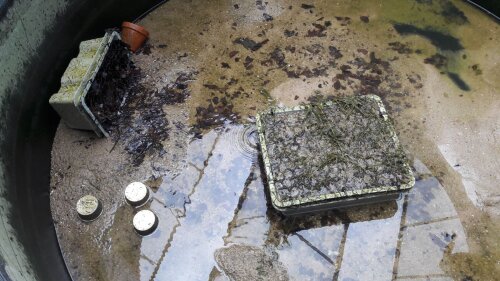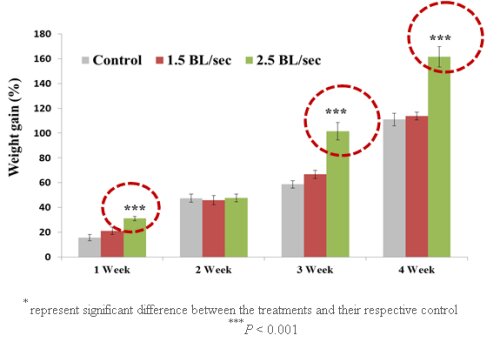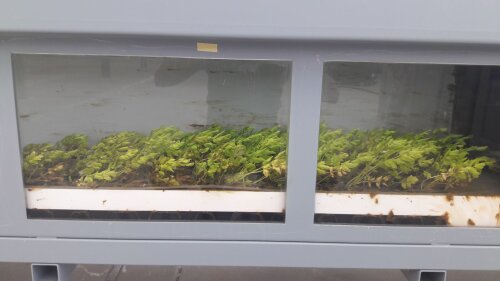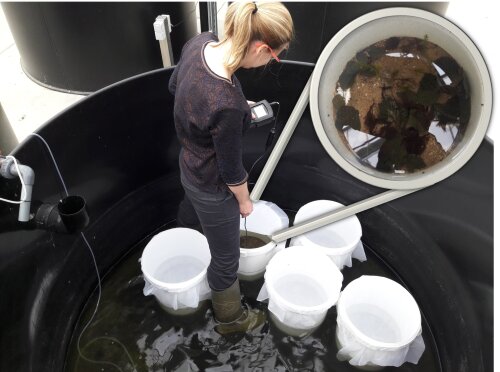Are Chinese Mitten Crabs a threat to our aquatic flora?
The Chinese mitten crab is an invasive exotic species in our freshwater ecosystems and the population seems on the rise in recent years, especially in the upstream reaches of rivers. In these upstream reaches, water plants flourish and fulfill a crucial ecological role in the ecosystem. The effect of the mitten crabs on this aquatic vegetation is poorly understood. A handful of laboratory test show that macrophytes are part of the crab diet, but not exclusively. Also some case studies in the field blame the crabs to have completely clear-cut the entire aquatic vegetation, though there was no conclusive proof for that. Our hypothesis is that mitten crabs are indeed capable of heaving a devastating effect on the aquatic vegetation, but only if this vegetation is already impaired or experiences considerable levels of (abiotic) stress. In this project we experimentally investigate whether crabs can have a negative effect on aquatic vegetation and whether this effect is bigger when plants are stressed. The studied stresses are EDTA-pollution and light stress, both factors are linked to the earlier mentioned case studies. Combining density data from literature and knowledge on herbivory pressure by certain crab densities will allow estimating the threat these crabs potentially are for the native flora in freshwater rivers.

Chinese Mitten Crabs have removed the majority of vegetation (Myriophyllum spicatum) in this mesocosm pond.
More information?
Contact jonas.schoelynck@uantwerpen.be
On television: http://deredactie.be/permalink/2.50807?video=1.3017672
Fitter fish grow better
In collaboration with Dr. Božidar Rašković from the University of Belgrade, sponsored by the EU COST Action FA1304 FITFISH, we examined whether common carp (Cyprinus carpio) juveniles grow better when swimming at different speeds. The trial lasted for 28 days and was undertaken in three large (1600 L) raceways at the experimental setup located in mesocosm facility at the University of Antwerp. Three groups of 100 fish were submitted to a constant swimming regime at different speeds: 0 (control), and 1.5 and 2.5 body lengths per second (BL/s). The results showed a significant increase in weight gain of common carp swimming constantly at 2.5 BL/s compared to both control and 1.5 BL/s group. Energy budget seemed little affected, but hepatosomatic index, and gene expression of the growth hormone receptor, insulin growth factor and cytochrome c oxidase significantly differed in 2.5 BL/s group at the end of the trial. The results of our study could potentially be very important to aquaculture: common carp show an increased weight gain during sustained swimming, possibly due to a beneficial hormonal balance. This principle of better growth with exercise is well established for salmonid species, but in our study common carp also showed beneficial effects of sustained swimming, even though it is perceived as “sluggish” fish, primarily because of its feeding habits in natural ecosystems.

More swimming excercise makes crap fish grow better.
More information?
Contact: gudrun.deboeck@uantwerpen.be
Effects of climate change on macrophytes
Climate change seems inevitable over the next few decades. The RCP6.0 scenario of the IPCC predicts the atmospheric CO2 concentration to double by 2100, and the associated climatic shifts will affect many ecosystems. However freshwater ecosystems are poorly studied compared to their terrestrial counterparts, and therefore we are uncertain as to how these systems will respond to climate change. On the other hand it is well established that the predicted changes in precipitation – longer droughts and more extreme rainfall events – will affect rivers and wetlands tremendously. Aquatic plants are some of the key primary producers in these rivers, which govern (i) the aquatic food web (plant material consumed by decomposers) and (ii) biogeochemical processing (nutrient and carbon cycling). Enhanced CO2 and increased nutrient concentrations may lead to an increase in the production of these aquatic plants. Yet the more severe flood pulses are likely to affect plant survival, leading to increased plant mortality and therefore an increase in litter in the system. Climate change may also affect aquatic ecosystems by affecting plants nutrient stoichiometry. Both plant quantity and quality are key driving factors for the aquatic decomposers' food web, which would have knock-on effects for the entire food web. In this research we are testing the effects of elevated CO2 and changing flow regimes on plant growth, biomass production, plant morphology (e.g. shoot to leaf ratio), plant physiology (e.g. photosynthesis and dark respiration), and nutrient stoichiometry.

Macrophytes (Berula erecta) grown in the Mesodrome flumes under elevated CO2 concentrations and high flow velocity.
More information?
Contact: rosanne.reitsema@uantwerpen.be
Combined effects of metal mixtures and natural stressors
In classical toxicity evaluations, an organism is exposed to a single chemical in the lab under constant, favourable conditions. However, in aquatic ecosystems chemicals often occur in mixtures, where they can interact and possibly result in enhanced or weakened toxic effects. Besides pollution, natural stressors, such as temperature fluctuations or predators, are present as well, which could also influence the toxicity. In the lab, we performed experiments on Asellus aquaticus, exposing this freshwater isopod to a combination of metal mixtures and natural stressors. This way we could study effects on the individual level and relate metal accumulation to relevant sublethal endpoints (e.g., growth rate, feeding rate). To gain more insight into the effects of metals on populations and communities, we also executed a microcosm experiment in the Mesodrome. Small ecosystems with several species of macroinvertebrates were exposed to Cu, Cd, Pb and a mixture of these three metals under semi-natural conditions. For two months, we observed the combined effects of metals and natural stressors on the individual level (accumulated metals, survival), the population level (species density, biomass) and the community level (species richness, evenness).

In these buckets, we exposed small communities (with midge larvae, isopods, molluscs,…) to single metals and metal mixtures.
More information?
Contact: marjolein.vanginneken@uantwerpen.be
Oxygen consumption of Atlantic cod related to Tail Beat Frequency
Gaining insight in the reparation rate of Atlantic cod at different swim speeds and at various water temperatures is a step towards understanding the mechanism behind important physiological parameters like energy use in this species. Studying this in a controlled situation provided us with crucial information that is needed to understand these parameters in a wild situation. Tagging the individuals with an accelerometer during respirometry measurements helped to parametrise swimming activity and oxygen consumption so that it will be possible to predict respiration rate based on accelerometer values.
The main goals of this project are to estimate a) possible effects of tags and tagging procedure on swimming capacity and biomechanics, and b) to estimate swimming velocities and oxygen consumption rates (respirometry) of free ranging tagged fish based on flow tank measurements of Tail Beat Frequency (video analysis) which is linearly related to swimming velocity, and Overall Dynamic Body Acceleration (accelerometry analysis), a proxy for energetics.
The results gathered in this study will help to estimate the effect of seismic industry activities on behaviour, ecology and environmental stress response of free ranging cod, which will help policy makers to define guidelines and boundaries